~SHAKER MUSEUM & EMILY ADAMS BODE AUJLA / SHAKER KNITS
‘THE COMMERCIALIZATION of SHAKER KNITS’
an exhibition EMILY ADAMS BODE ANJULA curated & organized with SHAKER MUSEUM
KINDERHOOK KNITTING MILL, 8 HUDSON STREET, KINDERHOOK, UPSTATE NY
up thru . . . SEPT 10, 2023
HRS: THURS – SAT / 10AM-6PM & SUN / 11AM-4PM
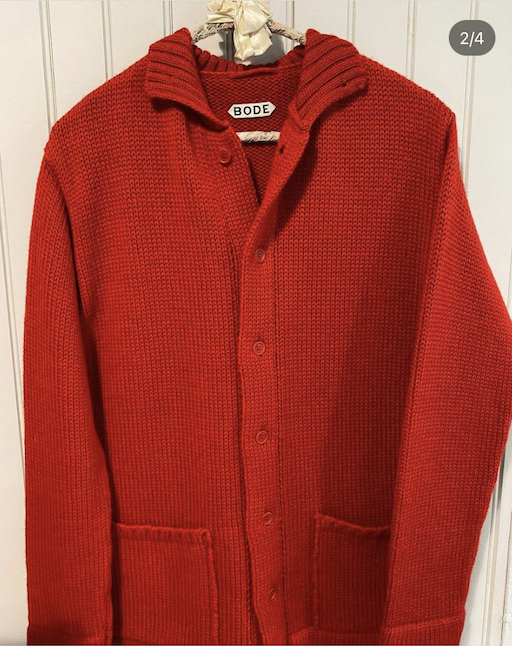
contemporary BODE ‘Shaker style’ / knit sweater
& that’s a mighty powerful red, if I ever did see one.
image via Instagram @shakermuseum
@shakermuseum: “In 1886, Canterbury Shakers received an order of 60 dozen pieces of knitwear. This inspired a single web knitting machine and high quality yarn. the result was a tightly knit pattern that was malleable without sacrificing strength. This lead to the rise in popularity among Northeastern Ivy League programs. Today, “Shaker Knit” refers to any knit that embodies the dense, durable quality of original Shaker Knits.”
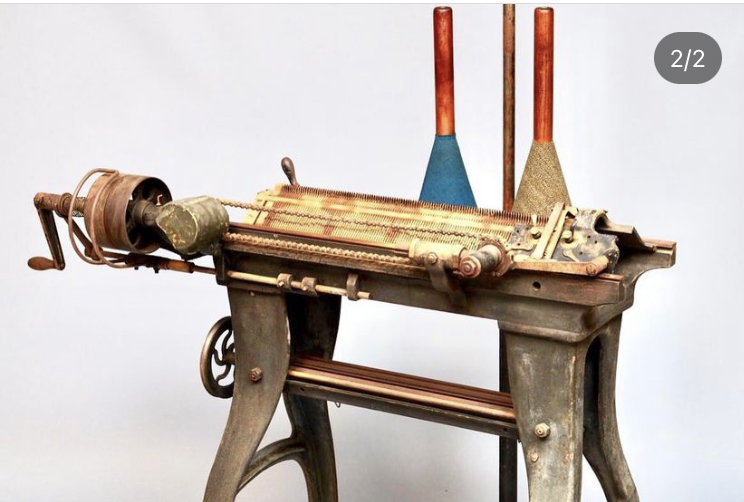
image via Instagram @shakermuseum
Knitting Machine, ca. 1899
@shakermuseum: “Knitting Machine, ca. 1899, used by the Community Makers, the Lamb Knitting Company, Canterbury, NH / New Hampshire. This machine was used for making sweaters.”
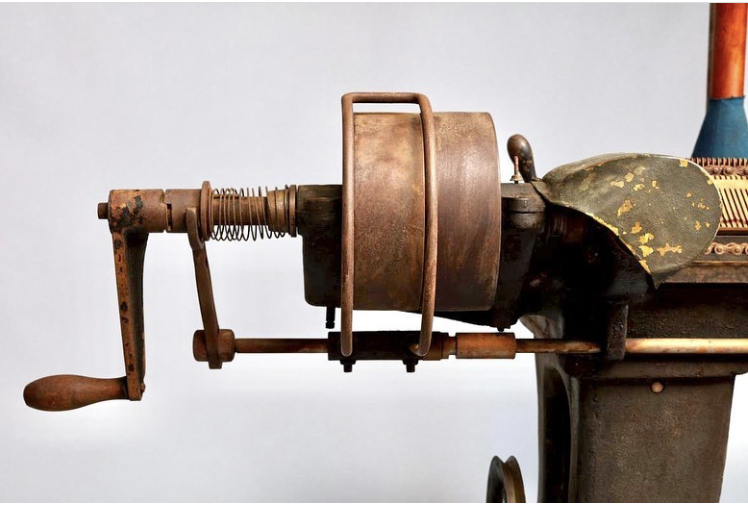
image via Instagram @shakermuseum
detail, Knitting Machine, ca. 1899
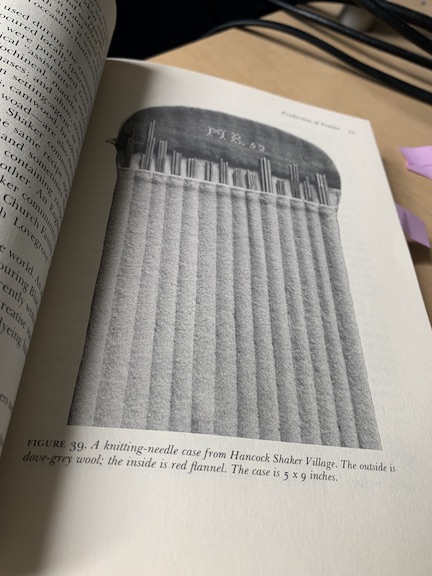
Figure 39. A knitting-needle case from Hancock Shaker Village. The outside is dove-grey wool;
the inside is red flannel. The case is 5 x 9 inches.
pg. 77, ‘Shaker Textile Arts’, Beverly Gordon.
(photographed on my desk …)
SOME BACKGROUND HISTORY via . . . . ‘SHAKER TEXTILE ARTS’,
by BEVERLEY GORDON / Published by the University Press of New England, 1980.
second printing 1983.
“KNITTING was an integral part of the lives of the sisters throughout Shaker history. They knitted all of the community members’ socks, stockings, gloves, and mittens, and most of their undergarments; and they made many of these items for sale. In later years, hats, washcloths, facecloths, sweaters , potholders, toys, rugs, and other items were also knitted and sold in Shaker stores.
“AT FIRST, all knitting was done by hand, and by any standards Shaker hand knitting was exceptionally fine. Knitting needles, or ‘pins’, were purchased locally, and all were less than size 00 in the measuring system we use today.
“STOCKING knitting frames were in use in New England as early as 1790, and knitting machinery was well developed by the middle of the nineteenth century. At least some, and possibly most, of the Shaker communities purchased knitting machines and put them to heavy use. Canterbury had a special knitting shop where the machines were kept. Great quantities of sweaters ans stockings were turned out by machine, but all were finished by hand. Sweater sleeves and bodices, for example, were machine-knit, but cuffs and edgings were hand-knit.”
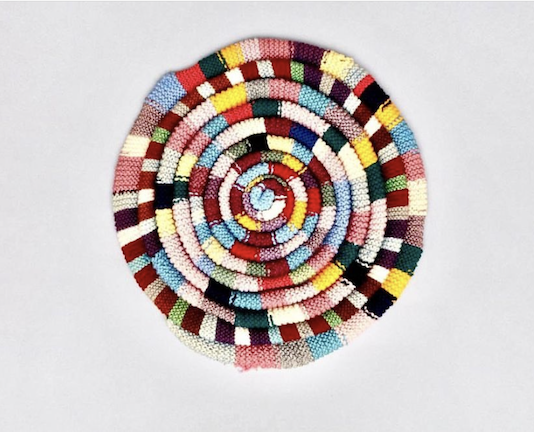
Shaker Knitted chair seat cover, Canterbury, NH. / date unknown, or not posted.
image via Instagram @shakermuseum
note: this looks to be ‘tube-knit’ / i.e. ‘corking’ aka done on a ‘Knitting Nancy’ (!!) / yarn wrapped around tacks imbedded into the tops of wooden thread spools, and looped. the ensuing ‘snake’ was then coiled, in this case into a seat cover. often a young child’s hobby.
or, used to be. does American Girl doll, ‘Felicity’ still come – with a ‘corking’ kit ?
continuing on,
with one more reference quote from . . . ‘Shaker Textile Arts’:
“COLOR: Many people assume that, given their emphasis on simplicity and modesty*, the Shakers used only dull, dreary colors. Though it is true that they avoided flashy colors, at least until late in the nineteenth century, they never set out to be drab. Early in the history of the sect, Believers were told they might use any color they could dye themselves, and Shaker dyebooks, mostly dating between 1830 and 1840 include recipes for various shades of red and scarlet, orange, brown, beige, rust, blue, gray, slate, yellow, lavender, and purple …. Later in the nineteenth century and certainly in the twentieth, (any) color restrictions disappeared completely. Synthetic (aniline) dyes were discovered in 1856, and by the end of the Civil War* a whole new range of bright, almost garish colors were generally available. The Shakers, like everyone else, loved the new and vibrant royal blues, purples, roses, pinks, greens, and reds , and there was never any question that they could use them.”
personal notes:
**likewise aniline dyed textiles crept into Native American weaving arts.
*’modesty’, now that’s a complicated word !! of course, modesty would be of paramount functional aim, in the clothing worn by a ‘communal’ sect, whose main tenet was celibacy . . . but, if you deep dive into their origins / it does comes to mind, that “running naked in the woods at night communally” . . “to show that one was not aroused sexually” and, that was therefore proof of one’s evolved / ecstatic spiritual pureness, was what got them kicked out of Britain / but perhaps, this is not the time or place. likewise, if one scrolls through the Shaker Museum Instagram page, the emphasis in on design skills, wonderfully made objects, and innovations. and I’m way okay with that, see above essay !!
but, I don’t see any ‘Talking with Spirits’ drawings !! though there is one lovely calligraphy drawing: Shaker Artist, ‘Word of the Savior’, 1843, ink on paper. Object ID: 1956.8113.1″
so, I’m thinking / how powerful the mysticism, and faith (!!) – that grew this incredible American design force.
“Put your hands to work and give your hearts to God” – Mother Ann Lee, Shaker founder.
